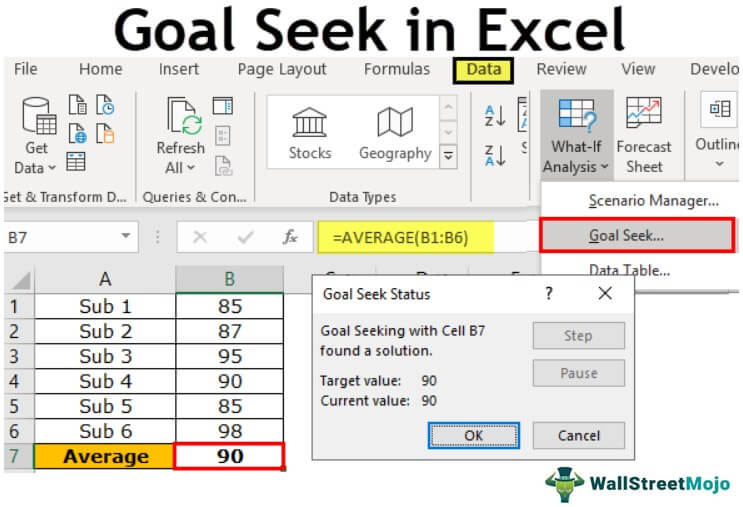If you are dealing with complex calculations in Microsoft Excel, utilizing the Goal Seek tool can ease the process and save valuable time. In this article, we will guide you through the process of using Goal Seek in Excel. First, let’s understand what the Goal Seek tool is.
What is Goal Seek in Excel?
Goal Seek is a built-in tool in Microsoft Excel that enables you to find out the input value required to achieve a specific output value. For instance, if you have a goal to achieve a particular profit margin, you can utilize the Goal Seek tool to determine the sales target necessary to accomplish that margin.
In simple terms, it helps you to achieve a specific goal by randomly vary one input argument until you achieve your required result. This way, you can accomplish your desired output without extensive manual calculations.
How to Use Goal Seek in Excel
Utilizing Goal Seek in Excel is a three-step process. Firstly, load the required input values and formulas you need to achieve your target. Second, choose the cell in which you want to establish the target output value. Finally, select the parameters you want to modify to achieve your desired output.
Step 1: Load the Required Input Values and Formulas
Before you can utilize Goal Seek in Excel, you must load the required input values and formulas. Your spreadsheet must contain an initial value, formula, and target result. Take, for instance, that you plan to acquire a loan for a home loan, and you need to find out the total loan amount that would give you monthly payments of $1,500. You already have a formula for your monthly mortgage calculation, but you want to determine the loan amount required to achieve your target result of $1,500.
In this example, the monthly payment is determined based on the loan amount, interest rate, and payment duration. The first goal we must establish is the value required for monthly payments. To establish this, we place the formula below in the target cell:
=B3+((B3*C4)/12)-C5
Once this formula is established, input the initial data for interest rate, payment duration, and monthly payments in cells C4, C5, and C6, respectively.
In this example, the initial loan amount is $200,000. The interest rate is 4%, and the payment duration is 360 (30 years). Monthly payments for this scenario amount to $954.83.
Step 2: Establish the Required Target Output Value
After inputting all your required formulas, select the cell in which you want to establish your target output value. As we are working towards a monthly payment target of $1,500 and our formula dictates that monthly payment is within cell C6, it stands to reason that we should input $1500 in cell C6.
By setting up the required output value, we inform the Goal Seek tool what we wish to accomplish.
Step 3: Select the Parameters That Require Modification
After establishing the parameters for step 1 and 2, it’s time to select the inputs that require modification to achieve the required output. In this example, we would utilize Goal Seek to vary the loan amount required to achieve a monthly payment of $1,500.
To use Goal Seek, select “Data” from the main Excel ribbon menu. Next, choose “What-if Analysis,” and then select “Goal Seek.” This will bring up the Goal Seek dialog box.
Within the Goal Seek dialog box, input the following data:
- Set cell
- To value
- By changing cell
The cell that contains the targeted output value. In our example, this would be the payment cell at C6.
The required output value. In our example, this would be $1500.
The cell(s) that Goal Seek should modify to achieve the required output value. In our example, this is the loan amount value located within cell B3.
Benefits of Using Goal Seek in Excel
There are several advantages to utilizing the Goal Seek tool in Excel. Some of these benefits include:
- Efficiency – The Goal Seek tool helps save valuable time by providing a shortcut to complex calculations.
- Cost Effective – By utilizing the tool, companies can prevent expensive errors arising from manual calculation methods.
- User-Friendly – The Goal Seek tool is simple to use and can be readily available to anyone using Microsoft Excel.
Frequently Asked Questions About Goal Seek in Excel
What is the difference between Goal Seek and Solver in Excel?
Solver is an add-in tool that’s utilized to find available solutions that fulfill necessary parameters, while Goal Seek is built-in and only aids in determining the beginning parameter for a specific solution. Solver is utilized when multiple variables should be set at specific values based on stipulated conditions.
When can I utilize Goal Seek in Excel?
Goal Seek is useful for all types of formula calculations that allow you to modify input values to achieve a specific target output. It is particularly valuable when dealing with complex calculations that would otherwise be time-consuming to complete manually.
Video Guide – How to Use Goal Seek in Excel
For additional guidance on how to utilize Goal Seek in Excel, check out this instructional video.

